neck carving, naptha, pickup cavity routing
click
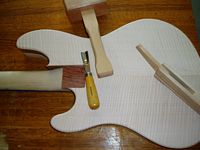
the edges were rounded with a router and 1/4" roundover bit, now it's time to carve a nice smooth transition from the neck to the body, the contour is drawn with a pencil
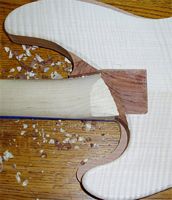

the left photo shows the neck after carving is almost finished, and the right photo shows the neck
after some sanding
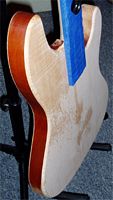
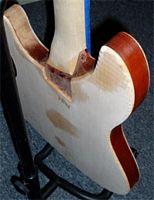

i wet the bass with naptha to simulate what it will look like under a finish that "wets" or darkens
the wood, unlike water, naptha doesn't disturb the grain when put on wood, i'm thinking about a light
tung oil finish (which will yellow the wood) sanded in with 400 grit sandpaper and a non-yellowing (non darkening)
varnish on top like Behlen's Water White Restoration Varnish, i still have to figure out how or if i'm going to close
the pores on the mahogany which is surrounded by wood I don't want to get pore filler on
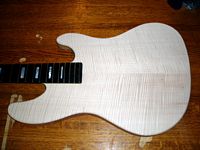

prepping the body for a bridge position jazz pickup cavity rout, in this case the bridge position jazz pickup is slightly
longer than the neck position pickup (to compensate for wider spread of strings toward the bridge)
so two different routing templates were used, the templates were carpet taped
to the bass and were almost impossible to get off afterward



bridge position pickup cavity about halfway done



testing the depth of the neck pickup, the wires for the neck and bridge pickups will be sent through
the wire channel routed into one side of the body before it was glued to the neck, see
here towards the bottom of
the page

the bridge pickup cavity wasn't routed as deeply as the neck cavity (I'm planning on setting up the strings slightly higher from the bass face as they move from the neck toward the bridge), you can see the maple from the neck with
bubinga on either side while in the neck cavity you only see bubinga due to its greater depth, i might route
the bridge cavity deeper after some more setup, a famous bass maker has said that routing out big chunks of the
neck and body between the fingerboard and the bridge is one of the most damaging things that you can do to the
transmission of string vibration which has so many consequences (sustain, dead spots, tone...), but to make this
type of instrument it's necessary, some makers, like Rob Allen, don't route any pickup cavities and use piezo pickups in the bridge
itself (although Rob creates huge chambers in the body of his basses in order to obtain an upright-like sound),
some use conventional pickups in conjunction with piezo pickups in order to expand tonal options,
others create no pickup cavities or body chambers (except for control cavities) and use infrared
pickups such as those offered by lightwave which are housed in the bridge
__Back__
Index














